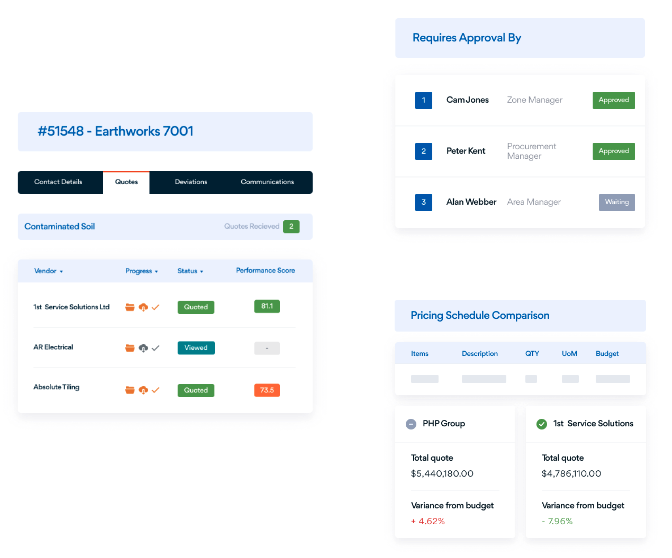Industry participants agreed that it’s not getting easier to source suitable third parties, according to the Building in The Dark report. In fact, 67% believed this process to be highly variable or very challenging.
To answer the question why vendor management matters, we want to start by discussing the role of the vendor in what has been termed the extended enterprise and the transition to the stakeholder economy.
The extended enterprise
As asset builders, owners or operators in the construction, energy, resources or government sector involved in capital works, we're seeing an increasing reliance on third parties and subcontractors within your supply chain.
This means that your own organisation's success, your profitability, achieving your business outcomes is increasingly tied to the success of that third party performing the role that you've entrusted them to. We refer to this as the extended enterprise.
However, the level of confidence in actually knowing your extended enterprise can vary. Only 11% of participants in the Building in The Dark report were fully confident in their organisation’s ability to name every party in its supply chain.
A 2019 Deloitte risk management survey of CEOs and boards found that 62% of executives fail to hold the extended enterprise to the same risk standards as their own organisation. These risks can be operational, such as delays, financial in terms of penalties, loss of revenue, reduced profitability, or reputational damage. The adage of the Courier Mail test: do you want your organisation on the front page of that paper?

The graphic here depicts these risks as defined by the Chartered Institute of Procurement and Supply and their white paper “Supply chain risk and resilience: A CIPS introduction to good practices”. However, risk is one side of the equation. There's also a financial upside. Deloitte believes that organisations who have a good handle on their extended enterprise can realise a 4 to 5% increase in return on equity compared to their peers.
“Know Your Supplier”
Similar to the finance industry’s “Know Your Customer”, “know your supplier” is increasingly critical. That means maintaining sufficient breadth and depth of data on your suppliers, such as details of company directors, especially for suppliers that you consider high risk. In summary, supply chain compliance is an enterprise-wide responsibility and collaboration is key for this
A recent AFR article noted construction-industry insolvencies jumped nearly 40% in the last 3 months of 2021 compared to the previous quarter, and increased 30% year-on-year.
This statistic emphasises why “know your supplier” philosophy is important, and the context of risks associated with the extended enterprise. If this is one of your suppliers, what would be the impact on your organisation in terms of business continuity and resilience?
Another anecdote here from a previous discussion with the New Zealand Water Authority. During the COVID experience, they came to realise which of their suppliers truly mattered. And it wasn't surprising that most of the important vendors were the ones with the lowest spend, not the most significant spend.
This emphasised to them the importance of knowing your supplier and highlighted a limiting factor which was they didn't have the technology to underpin the processes. They felt if they had, and they understood the importance of their suppliers, they would have bounced back from COVID much faster.
The stakeholder economy
Going beyond the extended enterprise is the concept of the stakeholder economy. The premise of this is that organisational accountability today goes beyond the shareholder and extends to your customers, suppliers, distributors, and also society and communities at large.
We've seen this with the introduction of legislation and compliance requirements including the Modern Slavery Act, local content, Indigenous procurement policies, and the Industrial Manslaughter Act.
Previously, the traditional approach has been financially driven, as we've often heard about sweating the asset. More and more, however, compliance evolves to reflect societal concerns.
As noted in the Building in The Dark report, “society’s expectation is what drives regulation.”

The procurement operating model
From an inwardly focused lens, internal complexity is cited as a significant challenge for most organisations. How procurement functions within an organisation can determine its effectiveness, as well as your risk exposure.
The procurement approach adopted is a maturity curve that most organisations go through. We’ve previously discussed the common procurement model evolution.
Here, we want to compare and contrast the two approaches: the traditional (centralised) approach and the hybrid approach (known as business or project-led, centrally enabled).

Let’s call out a couple of key points.
The first is the procurement department, and the shift from being finance-focused - where the emphasis is on reducing supplier cost for economies of scale - to “how do I work with my vendors to create value within the network?”.
The other key point here is the onboarding process. Traditionally, this is a complex process requiring significant procurement involvement.
Moving to the hybrid model enables this to become more of a risk-based process, which would simplify the process for suppliers, enabling our clients to focus on strategic engagement tasks, rather than spending time on administrative burden.
How technology can help
Before getting into real-life use cases, we want to highlight the core business sub processes within the procurement domain and specifically in supplier management and sourcing:
- Vendor prequalification
- Vendor database management
- Vendor relationship management
- Panel management
- Sourcing (rapid and strategic)
- Procurement scheduling
- Contracts
- Cross functional evaluations and approval
If you’re more familiar of viewing these processes under the Source-to-contract lifecycle, here goes:

A vendor management platform provides a single source of truth and a central repository for all of your vendors and their associated information. Ideally, there’s a self-serve vendor portal that empowers vendors to maintain their information and respond to sourcing events, while also increasing visibility and collaboration across your own organisation.
How Felix clients have tackled vendor management
In this section, we’ll go through some real-life use cases of our solution using the structure:
- The business problem that was the core driver for each of these use cases
- How Felix solved the problem
- The business justification – result
Use case 1 – Vendor prequalification and onboarding
The first use case relates to the onboarding and approval process for a water wastewater management company.
It's a two-step process first being prequalification, capturing that detailed information about your supplier and secondly, the internal approvals.
This organisation had a one-size-fits-all approach which was manual, time consuming and resource intensive, compounded by a large number of suppliers. Due to operating in 240 locations across the country. Their focus was to be able to execute the process in an efficient manner.
Felix provided a services specific qualification and sign-off process that was based on the supplier category and the ability to tailor their journey through that onboarding process and the internal approval process. Additionally, we integrate it into their ERP around the vendor record to automate this process, but also to restrict payments to non-compliant vendors.

Whilst the key justification was the seamless cross functional collaboration, and improving supplier satisfaction, by simplifying and reducing the time taken to onboard suppliers, this is very much about the stakeholder economy and partnering for success. Most importantly, the reason for performing prequalification is to ensure that you have the appropriate suppliers performing the work.
“56% of participants believed their organisation had unknowingly engaged an entity red-flagged by another area of the organisation.” Building in The Dark report
It’s statistics like this that truly highlights the need to focus on your suppliers as part of the extended enterprise.
Use case 2 – Meeting ESG requirements
This next use case relates to the full source-to-contract lifecycle for a number of major infrastructure projects across the country.
The business problem was adherence to strict sustainability and reporting targets for Indigenous engagement, local content, and social enterprise. They had limited visibility across the full S2C lifecycle. Thus, this is very much about the stakeholder economy.
The way we solve the problem was with our strategic sourcing suite, linking to a list of prequalified suppliers from the beginning. We provided a collaborative evaluation of tender processes in a real time approach across the organisation, and monthly surveys to fulfil the reporting requirements on industry participation.

A key justification was the reduced time for approval to release RFQs. Previously, this involved eight to 10 wet signatures on a page, carrying the document between locations around the country and could take four to seven weeks. After the implementation of the Felix solution, this was down to one to three days.
More importantly, though, as we discussed around the stakeholder economy, they increase the inclusion of local and indigenous participation in RFQs and award. Given the increasing public sentiment around sustainability, there is a possibility of reputational risk.
Thinking of this, many organisations have set targets around sustainability which are featured in annual reports brand reputation and investor confidence on the line here. Failing to meet government impose quotas is one thing. Failing to meet your own self-declared sustainability goals in the public eyes another.
In summary
We have a backdrop of an increasingly complex business environment, with 88% of surveyed participants believing organisational risk profile and cost of doing business are increasing (Building in The Dark report).
Vendor management is about building trust and having mechanisms in place to safeguard it. Whilst the construction industry has been infamous for operating on razor thin margins, effective and efficient third-party risk management is no longer a nice-to-have, it’s make-or-break.
---
Based on the webinar “Why Vendor Management Matters Now More Than Ever” - Watch the full webinar recording for more use cases.
Related Articles

Building high-performance procurement teams
As talent shortages sweep through the construction industry and impact productivity, procurement is starting to feel the effects. Focusing on increasing the performance of your procurement team is important to delivering long-term outcomes.

Greater supply chain transparency and diversity will drive construction’s sustainable future
As the Australian government attempts to deliver one of the greatest infrastructure booms in its history, there exists a prevailing and urgent threat to its impact on people and planet, including on the health and well-being of its workforce.

Emerging cybersecurity risk in the supply chain the next wave in construction’s perfect storm
The construction industry’s persistent labour shortage and escalating material costs have created the perfect storm, as seen in the recent shock collapses of two major Australian construction companies.
However, another emerging area of concern is cybersecurity risk in construction, as the cyber attacks to an organisation’s supply network could form the next big wave for which they remain precariously unprepared.
Let's stay in touch
Get the monthly dose of supply chain, procurement and technology insights with the Felix newsletter.



